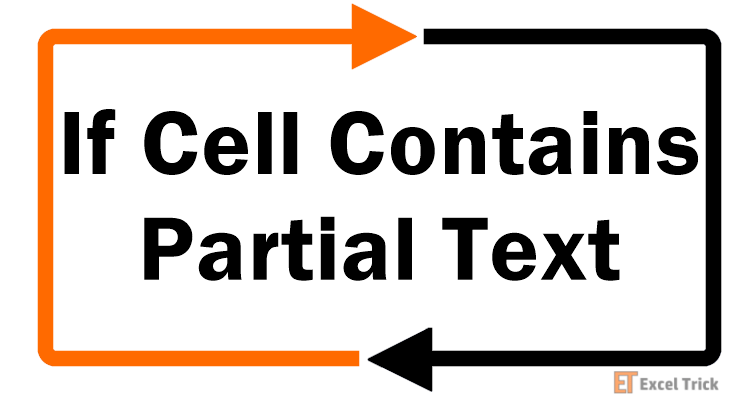Smart searching makes the whole search process a breeze and that's smart stuff for you, making everything easy breezy. As your search gets specific, the process gets more complicated and if you don't employ the right techniques, you'll find yourself having a bad fishing day in a ginormous Excel sea. See if you can get it right the first time with what we have planned for you here today.
Your learning today comprises checking cells for partial text using the SEARCH, COUNTIF, and MATCH functions along with other functions to control the outcome. Find out how to use wildcard characters to aid the search. We'll use a case example to give the explanations a visual touch.
Case Example
Enlisted ahead in the example shot, we have our stock of fragrances. The fragrances are alphabetically sorted by name and the slight problem here is that the brand is also mentioned in the same cell. Now if we are to find fragrances according to a brand, we can't do it as easily.
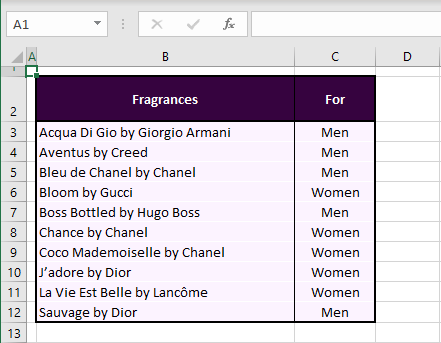
A start can be to split the brands from the names into a separate column but even then, we have a problem. If we alphabetically sort the brand names and search for a fragrance by Armani, our search will turn up pointless because the fragrance is listed by the name of Giorgio Armani and would be lying in the range of G while we'd be searching the brands with A as the initials.
So we need something a little more foolproof for our searches and we've expounded these ideas ahead in this tutorial.
Let's get checking!
Method #1 – Using SEARCH Function
Partial text in a cell can be checked with the SEARCH function. The SEARCH function searches a cell for a given value and returns the position of the character at which the value is found. That's how the SEARCH function will work on its own but there are ways to use the SEARCH function to expand its usability.
We can better look into this with an example so let's merge our case example with the SEARCH function and apply the formula below:
=IF(ISNUMBER(SEARCH("Chanel",B3)),"Yes","-")First we'll talk about the SEARCH function. We want to find fragrances by Chanel in our stock and we have fed this brand name in the formula. The point of search is column B hence, the first cell to search is B3. Technically this should be enough, right? Let's apply just the SEARCH function and see if it works:
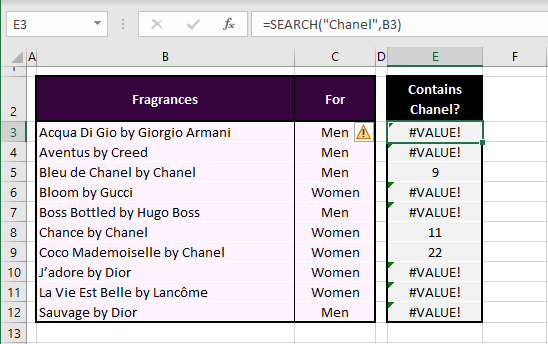
Now that works… partially. The SEARCH function returns the position of the character where Chanel is found i.e. the 9th character. Since SEARCH couldn't return the character's position in the first instance (because B3 doesn't contain the value "Armani"), it results in the #VALUE! error. While the SEARCH function on its own does something to give us the idea that the searched value is there, we need something more suitable for our spreadsheets.
Incoming: the ISNUMBER function. ISNUMBER returns TRUE when the provided value is a number and FALSE when it isn't. This way, the ISNUMBER function will result in TRUE when SEARCH results in a numeric value and FALSE otherwise.
But we're going for further prominence in the results and that's why we've wrapped everything in the IF function. The IF function will yield a "Yes" upon finding "Chanel" as part of the cell value. Otherwise it will yield a dash "-"
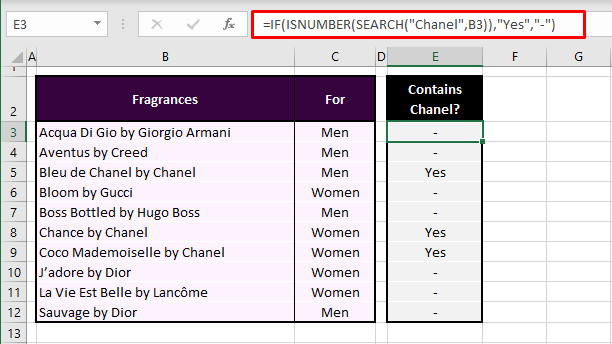
With more clarity, we can easily see that we have 3 Chanel fragrances in stock.
Notes:
The SEARCH function doesn't require a wildcard asterisk but a wildcard question mark can be used to replace a single character. Find out what a wildcard character is in the COUNTIF function section.
The SEARCH function is not case-sensitive. Switch it out with the FIND function for a case-sensitive option.
Checking Two Values
Checking our stock for Chanel was one value. Let's also search for Gucci fragrances because why not? For searching two values, we will need the OR function. The OR function returns TRUE if any of the specified conditions are met and FALSE if none are met. Now see the formula with the SEARCH function for checking if a cell contains either of the two values:
=IF(OR(ISNUMBER(SEARCH("Chanel",B3)),ISNUMBER(SEARCH("Gucci",B3))),"Yes","-")We're finding two values so the formula has 2 SEARCH formulas; one with Chanel as the search value and one with Gucci. Both the SEARCH formulas are controlled by the ISNUMBER function. The OR function is fed with two conditions; find Chanel or find Gucci. If either is found, the IF function makes sure that "Yes" is returned. Else, a dash is returned.
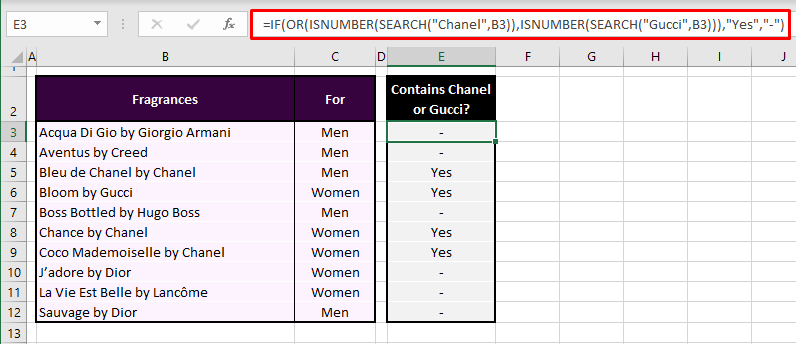
Note: Suppose instead of finding two values in separate cells, you want to find two values in the same cell. E.g. we're unable to recall the full name of a fragrance by Chanel but remember that the name included "de". In that case, the OR function will be replaced by the AND function and the search values will be "Chanel" and "de".
=IF(AND(ISNUMBER(SEARCH("Chanel",B3)),ISNUMBER(SEARCH("de",B3))),"Yes","-")Method #2 – Using COUNTIF Function
An alternative to the SEARCH function for checking partial text in a cell is the COUNTIF function. The COUNTIF function is used to count the cells that meet a given condition. COUNTIF makes a lighter formula for finding partially matching text since the ISNUMBER function can be dropped.
The added touch is, however, having to use a wildcard character to match zero or more characters. In the coming sections, we'll show you how to use the wildcard characters (the asterisk and question mark) within the COUNTIF function to check if a cell contains certain text.
Wildcard Characters
With Asterisk
The COUNTIF function needs to be triggered for searching part of the text in a cell with the asterisk in the formula. The asterisk acts as a replacement for zero or more characters and without it, the formula will search a cell containing just search text instead of searching a cell that includes the search text. The asterisk will be placed depending on the position of the text you want to find within the cell. Here's a little helper:
| Criterion | Parameter in the formula |
|---|---|
| Find text at the beginning of a cell | "text*" |
| Find text in the middle or anywhere in the cell | "*text*" |
| Find text at the end of a cell | "*text" |
Judging from the above, the asterisk can also be placed at the end of Chanel if we're unsure of any text after it in the cell. A safer bet will be to enclose the search text in asterisks because the presence of one can always account for zero characters but the absence will mean that there is no text.
Let's proceed to the formula now so you can see how this works:
=IF(COUNTIF(B3,"*Chanel"),"Yes","-")The COUNTIF function is to return 1 for a cell containing "*Chanel". The asterisk is placed before the text of interest because we know that the brand name will be the last part of the text in the cell. If the cell does not contain Chanel as the last of the text, COUNTIF will return 0.
To customize 1 and 0, we have added the IF function in the formula to replace these numbers with "Yes" and "-" respectively. These are the results:
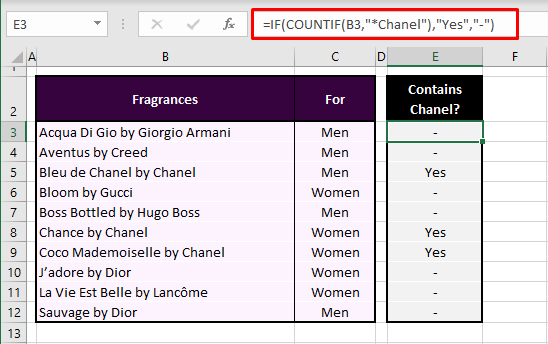
Search a Range
In the case above, we were seeing which fragrances by Chanel were in stock. If we were only out to check whether the stock contained any Chanel fragrances at all, without specificity, we can apply the COUNTIF function to the whole range in the dataset and get a single cell result in return. In Excel words, the COUNTIF function works on a range as well as a single cell. Use this formula to check a range for partial matching:
=IF(COUNTIF(B3:B12,"*Chanel"),"Yes","-")The only thing we have changed in this formula is the cell reference from B3 to the range B3:B12. The formula searches this range for cells that contain Chanel as the ending text. Since there are 3 cells in this range that meet this condition, the formula gives us a "Yes" in a single cell.
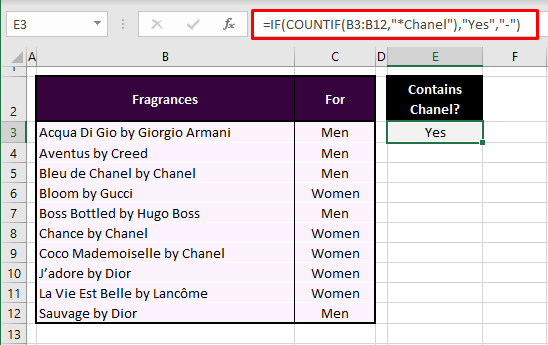
With Question Mark
Another wildcard character with an interesting characteristic is the question mark. While the asterisk can signify multiple characters, a single question mark signifies a single character and more than one can be used.
Let's draw from our case example. We are certain there is a Lancome fragrance in our stock but can't quite remember what spelling the entry has been made with. Was it Lancôme or Lancome? Don't sweat it. It's just the O causing dubiety and we can replace it with a question mark wildcard. Use a formula like this to check for partial matching using a wildcard question mark:
=IF(COUNTIF(B3,"*Lanc?me"),"Yes","-")Only changing our search text in this formula, the rest is the same COUNTIF we were using earlier. Now we are searching for a Lancome fragrance with a leading asterisk because the remaining text is before the brand name in the cell. The dubious "o" in Lancome has been replaced with a question mark.
Applying this formula to all the fragrances in our dataset, we have one "Yes" returned for B11, solving our mystery spelling as Lancôme.
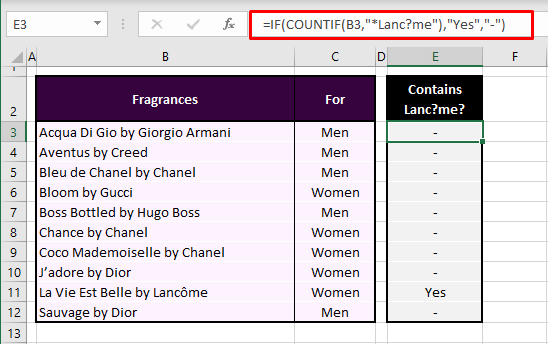
Notes:
The COUNTIF function works for ranges too so it can also be applied as a range formula, depending on what your requirement is.
Method #3 – Using MATCH Function
The last option for checking a cell that may contain your search text in part is the MATCH function. The MATCH function checks an array for a value and returns the position of the cell in that array. We can work with that. If the position of the cell in the array is what we insist on, then we can do with using just the MATCH function. But we're finding a specific text in a range so we'll throw more spanners into the works. Keep reading!
Wildcard Characters
With Asterisk
With the MATCH function, we also need to use the asterisk as a wildcard. We require other functions like in this formula ahead:
=IF(ISNA(MATCH("*Chanel*",B3:B12,0)),"Not Found!","Found")The MATCH function has been equipped with Chanel as the first parameter enclosed in two asterisks to replace possible text. The lookup array is B3:B12 and 0 has been entered to find an exact match. When the search text cannot be found, MATCH will result in a #N/A error and for finding every match, 1 will be returned.
To channel #N/A and 1 into TRUE and FALSE, the ISNA function has been added in the formula. the ISNA function returns TRUE when a value is #N/A. Now the TRUE and FALSE are in guise with "Not Found!" and "Found" by the IF function respectively.
The MATCH function picked up on 3 cells that contain the text Chanel. ISNA checks for an #N/A error. Since MATCH's result is 3, there is no #N/A error – leading to FALSE. The value for FALSE as per the IF function is "Found". The indication is that the search text Chanel has been found in the range B3:B12.
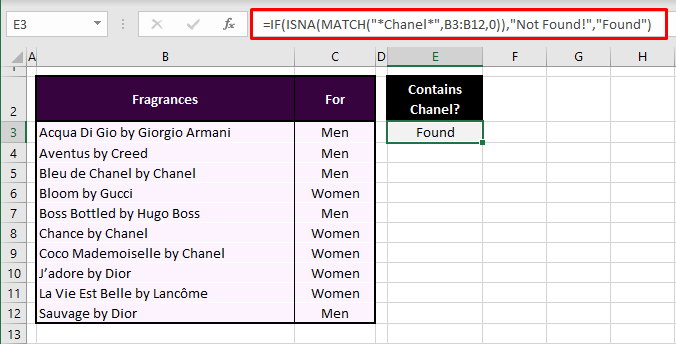
The same formula can be used with the range excluded and relative cell reference included to find the exact cells that contain the matching text:
=IF(ISNA(MATCH("*Chanel*",B3,0)),"Not Found!","Found")
With Question Mark
Now let's see how to use the question mark as a wildcard character with the MATCH function for finding partial text in a range.
=IF(ISNA(MATCH("*Lanc?me",B3:B12,0)),"Not Found!","Found")With the same lineup of the MATCH, ISNA, and IF functions, we've entered the search text with a wildcard question mark to find Lanc?me in B3:B12. And good news, it has been found.
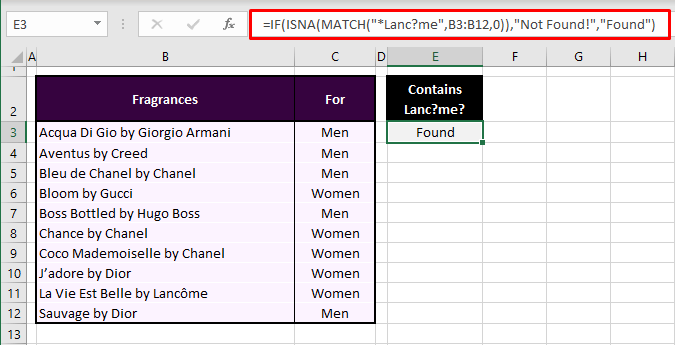
Open up the results by using a cell reference instead of the range to specifically find the cell that contains the Lanc?me fragrance:
=IF(ISNA(MATCH("*Lanc?me",B3:B12,0)),"Not Found!","Found")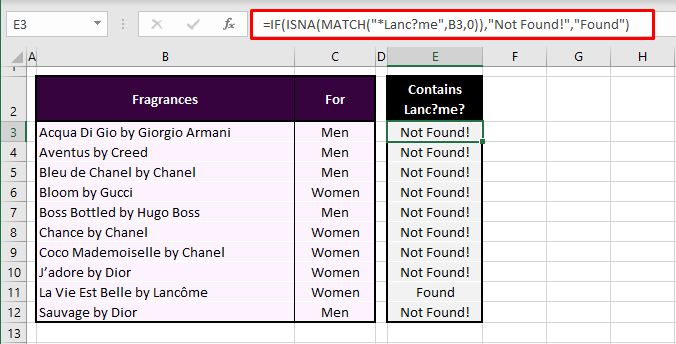
One more thing this tutorial contains is the end of the tutorial so we're heading out of finding partial matches in text in Excel. But if this is new for you, get cracking with some text search experiments and before you're ready to head out, we'll be back with more Excel stuff to crack. You can count on us for that!
